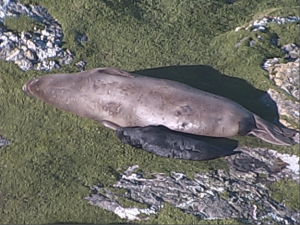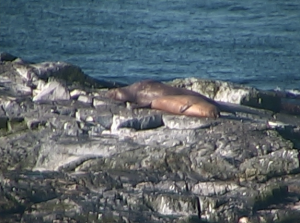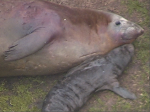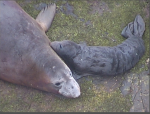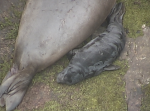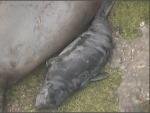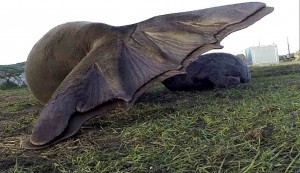Nothing goes wasted in an ecological system. A few hours after the birth of the baby elephant seal, Thayer’s Gulls, Ravens and Black Turnstones came by to get a bit of rich protein for the placenta.
Tag Archives: e-seal pup F076
Early morning of the Birth of the Elephant Seal
In the early morning just after the birth of the Elephant seal pup, Alex was able to record behaviours of the mother and Pup. Gulls started to go after the placenta, opposed by the mother.
This video was made from clips taken between 0814 hours and 0830 hours.
Shooting the Elephant seal Images
Alex uses a Pro-cam video camera at Race Rocks to take video and some still images of the Elephant seals close up. In this sequence, taken on the day after the birth of the elephant seal. He places the camera and then leaves, capturing an interesting sequence as the pup tries to find milk and the Male “Chunk” starts to get aggressive. Click on the small icon in the lower right for a full screen image
An assertive little elephant seal pup video
A short sequence showing the pup is certainly assertive!
Family has relocated on Great Race Rocks
Bertha has certainly been cooperating this year in remaining in view on at least one of the cameras at Race Rocks. On this bright sunny day she is on the rocks over behind the boathouse with the Pup.
Vocalization of Elephant Seal Mother and Pup
Vocalization of mother and pup are essential shortly after the birth of an elephant seal to establish a bond and for recognition of each other if separated in the pupping colony. The first video was taken on the afternoon of January 14, day 1 the pup can be seen looking for food, but she had not started to nurse yet., The second video was taken on the evening of January 14, 2014 the day the elephant seal was born at Race Rocks.
Videos by the Ecoguardian, Alex Fletcher.
The Future for our Elephant Seal Population?
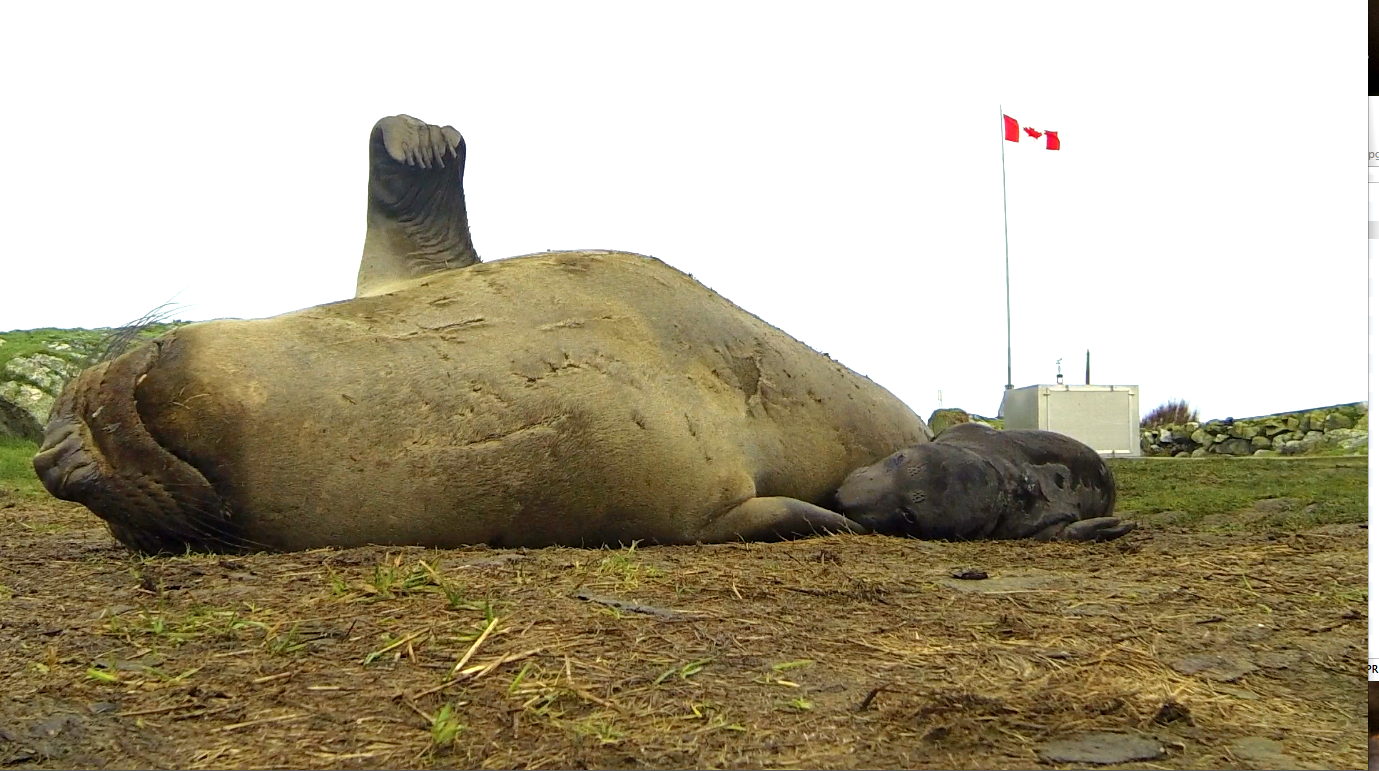
A goodbye wave?? Female elephant seal and pup born at Race Rocks , January 14, 2014 : Alex Fletcher photo
British Columbians can take great satisfaction in the fact that an Elephant seal colony is being slowly established in British Columbia, and we can see an elephant seal pup being nursed via a webcam on an island within site of Victoria. The reality is that the risks these animals face in the Strait of Juan de Fuca if they are to maintain a population increase are now becoming even more challenging.
Currently about 6,000 large commercial vessels transit Canadian and U.S. waters toward Vancouver or Washington ports each year. Each month about five large oil tankers ply the waters down the international border within a few kilometres of the Race Rocks Ecological Reserve.
Under the Kinder Morgan Pipeline Proposal, up to 34 tankers a month would be loaded with oil at a terminal outside Vancouver, then travel through Haro Strait and the Strait of Juan de Fuca for export to markets in Asia and the U.S. These are tankers in excess of 200 metres in length.
The $5.4 billion expansion project would nearly triple pipeline capacity from about 300,000 to 890,000 barrels of crude oil a day to meet customer demand. Much of that future cargo will likely be diluted bitumen from Canada’s tar sands. If approved, the expansion is expected to be operational in late 2017. The pipeline is operated by Kinder Morgan Canada and owned by Houston-based Kinder Morgan Energy Partners LP.
The potential of collision and oil spills is unparalleled, and you can’t’ clean oil off a two ton marine mammal very easily let alone the volumes of marine life it consumes daily for survival. It would be a miracle indeed if we still have elephant seals at Race Rocks in 2020, the 40th anniversary of the Ecological Reserve.
G.Fletcher
Link to other posts on the Race Rocks website about the Risks we face with Increased Tanker Traffic
References we could all consider seriously:
- Financial Liability for Kinder Morgan – Georgia Strait Alliance,
“Residents of the Salish Sea region—Vancouver, Victoria, the Gulf Islands and Washington State—could see a four-fold increase in the number of oil tankers traveling from the Port of Metro Vancouver through Juan de Fuca Strait, if Kinder Morgan is permitted to build a new pipeline to carry oil from the tar sands to markets in Asia. Such a dramatic increase signals exponentially higher risk of oil spills and raises many questions about what is at risk, how the oil is “cleaned up”, and who pays for oil spill response. “
- The Deepwater Horizon Oil Spill and Marine Mammals by the marine mammal Commission, an independent commission of the US government
- Effects of Oil Spills on Marine and Coastal Wildlife—“Oil spills can impact wildlife directly through three primary pathways: —ingestion – when animals swallow oil particles directly or consume prey items that have been exposed to oil .—–absorption – when animals come into direct contact with oil inhalation – when animals breathe volatile organics released from oil or from “dispersants” applied by response teams in an effort to increase the rate of degradation of the oil in seawater. ——inhalation – when animals breathe volatile organics released from oil or from “dispersants” applied by response teams in an effort to increase the rate of degradation of the oil in seawater”
- Effects of Oil Pollution on Marine WIldlife ” Seals are very vulnerable to oil pollution because they spend much of their time on or near the surface of the water. They need to surface to breathe, and regularly haul out onto beaches. During the course of an oil pollution incident, they are at risk both when surfacing and when hauling out.”
- Marine mammals and the Exxon Valdez Auteur : LOUGHLIN Thomas R. “This recently published book is a unique longitudinal study of the demise of an ecosystem due to a single acute environmental perturbation.”
kayak disturbance, tagged e-seals, pup, etc
Wind has varied between W and NE less than 20 NMPH over the past few days. We have had some patches of fog during the week and partly clear skies today and yesterday.
On the 15th a group of 20 kayakers passed through the reserve on the East side heading West. They passed on both sides of East rock and caused one of the largest sea lion disturbances I have seen here, several hundred sealions scrambled into the water. I was able to talk to one of the kayakers as they passed by the south side and told him that they are not allowed to cause this kind of disturbance to marine mammals at race rocks. Though I love kayaking and prefer kayaks to motorized vessels, kayakers need to realize that because they are so nice and silent they can also easily surprise wildlife. Once startled sealions stampede and can easily trample younger sealions or injure themselves rushing over the jagged rocks.
1 dive boat in the reserve today, 1 eco tour in the afternoon, 1 sports fishing boat in the morning which traveled too close to sealions on the East rocks. I called Pedder Bay Marina and gave them the ID number and a description and asked them to talk to the operator about regulations at Race Rocks (thanks Pedder Bay Marina!).
- go pro camera anchored on a 9lb maul head got a bit run over
The elephant seal pup seems to be in good shape and is drinking milk regularly. Chunk seems fairly well behaved, a few times a day he we will arise from his slumber and chase after Bertha. Sometimes it seems he is trying to separate her from the pup and restrain her. I have seen him with his mouth around the pup’s head as well as with the pup partly underneath him though on all occasions I have observed he has clearly not harmed the pup when he easily could have. Chunk went off the island last night, I assume to middle rock and was back in the morning. There are two elephant seals on middle rock, both fairly large, one possibly a young male. I have been hearing what sounds like a male’s call coming from middle rock today. There were also two smaller scruffy, moulting female elephant seals in the shoreline of the main island today one tagged green 7502 the other tagged pink N93_ the last number is not visible. That brings the current e-seal population to 7.
Past week maintenance:
-cleaned solar panels daily
-flushed media filter on desal
-changed pre-filters on desal
-troubleshooting cam 5 with help from Jonathan, replaced POE unit. took measurements to replace leaky cable housing at base of cam stand
-ran desal x2
-ran fire pump
-replaced leaky hydraulic line on crane, pressure tested line
-cut, chopped, stacked fire wood
-replaced fire extinguishers which had been sent in for annual servicing
-brought temporary fire extinguishers off island for servicing
-troubleshooting of failed internet system with help from Jonathan
-swapped out 1 propane tank on main house
Visitors this week:
-on the 15th Erik came with a guest to drop off supplies
-on the 16th Erik brought Jonathan out to replace switch in the tower as well as the Marine sciences class for a field trip (12 students and Ann)
Elephant Seal Pup Losing the Wrinkles
Comparison of screen captures from the remote camera over the past 2 days shows that the pup must be nursing well as his wrinkled skin is gradually becoming filled in. The mother will lose up to 40% of her weight while nursing. She will stay with the pup, not returning to the water for several weeks. At that time the pup will have increased in weight and have the adequate fat storage to last it several weeks before it goes to the water on its own and starts to feed.
- 9:45 AM Jan14 a few hours after birth not slim
- 9:45 AM Jan 14
- Jan 16-1:27 PM note loss of wrinkes
- 2:26 PM Jan 16 note increase in size and loss of wrinles.
